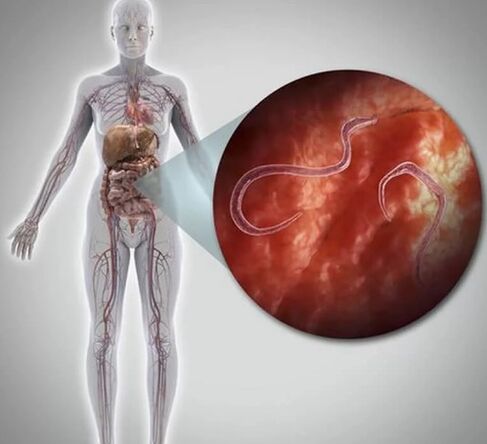Human parasites are parasites whose infection is subjected to a person. The overall definition of the word "parasite" applies not only to multicellular and protozoa, which lives at the expense of their owner and to the detriment of the latter, but also viruses, bacteria and similar quality fungi. According to historical tradition, and from the perspective of medical parasitology, it is common to call any creature that guides a parasitic lifestyle, except for viruses and similar bacteria.

Parasites include many helminths, fungi, viruses, protozoa, worms, crustaceans, spider formed, insects. Owners of parasites can be bacteria, simpler, plants, animals and humans. Parasites undergo a complex development cycle: sometimes they need a change of 2-3 owners whose body is intermediate (helminths pass the stages of larvae) or final (poisons become invading).
By history:
The study of parasites in ancient people is based on the study of feces and other pelvis material. The earliest parasites found in man were Paragonia Westerman's eggs from Northern Chile, discovered in hardened feces and dated approximately 5900 BC. e. In Brazil, the worm eggs were also found from 5000 BC. e. , In Peru - Nematode eggs from 2330 BC. e. And Egyptian midwives dating from 2000, 1250 and 1000 years. Before Christ e. They contain a Soliter egg, along with a well -preserved female worm.
In Berlin, for the period 1866-1875. 16% of all open corpses contain worm worms. Bull taperly (Taeniarhynchus saginatus) was particularly widespread where the meat of raw cattle was eaten. In St. Petersburg, according to Kessler, 3. 66 % of the persons investigated by him suffered from this parasite (1888). Pork Silence (Taenia Solium) is found everywhere in areas where they eat raw or half -long pork. In St. Petersburg in the late 19th century, about 3 % of the population suffered from this parasite. When they began to avoid the use of raw meat, the percentage of diseases decreased extremely, for example, in Denmark from 53 % to 20 % for 10-12 years. Dypilidium caninum lives in the intestines of dogs and cats, and rarely in the intestines of children. Cases of infection of children in the late 19th century were known by England, Germany, Denmark: Infection occurs exclusively when fleas are swallowed.
Parasites and their discharge(Products of their lives) are the strongest poisons for the human body. They cause severe acidification and blood thickening and the entire indoor environment. They provoke the most serious health disorders. From bronchitis to oncology. Destroy a person's psyche, deprive peace and sleep. In the child's body, parasites prevent the normal development of the child's nervous system and, with a long current disease, contribute to mental and physical retardation.
ClaSSIFICaTION
By distribution:

On biological and epidemiological features:
Depending on the localization of the parasite in the body:
In the place of residence in the owner:

How do parasites enter the body?
Parasitism can be infected not only through dirty hands. Animal hair is a carrier of worms (ascarides and toksocara), lamblia. Worm eggs that have fallen from wool remain for up to 6 months and through dust, toys, carpets, underwear and beds and hands fall into the food tract. A dog through wet breathing distributes eggs at a distance of 5 meters (cat - up to 3 meters). Dog fleas also tolerate worm eggs. Ascarid eggs enter the body through vegetables, fruits, berries, greens, dirty hands, and also spread to flies. And incorrectly cooked barbecue or home -made bar is the way of infection with trichinellosis; Salted Salt Fish, caviar - opisthorchiasis and wide tape.
So there are some ways to access the body:
Symptoms of parasites
It is not at all necessary for the infection to be somewhat manifested at all. Sometimes a person feels healthy, regardless of occupation, thanks to strong immunity. Some individual time it will be healthy. Then, accordingly, the disappearance of immunity (a division can occur at any moment of stress, surgery, illness) - the parasite of quiet signals will still begin to serve. It is a windy urine, acne on the skin, stubborn coughing with clean lungs, unstable excrement with a strong odor or constipation, gas formation, unpleasant odor from the mouth. The most specific manifestation of the presence of helminths in the body is bruxism. Night saliva, ordinary nausea, perversion of night hunger appetite, impenetrable hunger, dependence on sweet and acidic foods and air belching. Children have a decrease in appetite or election appetite. Sometimes people with adult appetite are found, but at the same time they lose weight.
General signs of parasitic invasions
Constipation, bile stagnation

Some worms, due to their shape and large sizes, can mechanically close the intestinal lumen, bile tract canals, which leads to a deterioration in peristalsis, constipation formation, complete or partial intestinal obstacles. The hlybon occupation can provoke blockage of the usual bile duct, which leads to difficulty in the emergence of bile, mechanical jaundice.
Diarrhea
A number of parasites, especially protozoal ones, produce substances similar to prostaglandins, which lead to sodium and chloride to loss, which, in turn, provoke diarrhea - frequent bowel movements.
Stomach and intestinal discomfort syndrome
Parasites living in the upper intestine cause inflammation and lead to intestinal breakdown, bloating. This leads to a decrease in nutrient absorption. As a result, the fats to be absorbed in the small intestine fall into the colon, provoking cramps, alternating constipation and diarrhea.
Pain of the joints and muscles
Parasites can move around the human body in order to place them in the most appropriate places, for example, in the common fluid and in the muscles. Inflammation of the fabric is the result of their damage with parasites or body immune response to their presence. At the same time, a person experiences muscle and joint pain.
allergy
Parasites can disrupt the normal permeability of the intestinal mucosa, which increases the risk of penetration of large food particles into them. This activates the body's immune response - the level of eosinophils - our body's blood protective cells, which contribute to the development of allergic reactions, increases. Parasites cause increased production by the body of immunoglobulin E, which increases allergic reactions.
Problem -skinned
Intestinal parasites can cause allergic skin reactions - atopic dermatitis, urticaria, eczema. Most often, inflammatory changes in the skin can be the result of the presence of protozoa microorganisms (lamblia, fungi) and opistrchis.
Ndryshimi i peshës së trupit
Luhatjet e peshës (si më shumë se normale ashtu edhe më pak) mund të jenë rezultat i një sëmundjeje parazitare. Ulja e peshës është për shkak të faktit se tretja është e dëmtuar në trup, pasi ekziston një "konsumator i brendshëm". Obeziteti është gjithashtu një pasojë e "grabitjes" e trupit të njeriut me pushtim helminthik. Feeling of hunger occurs with a sharp drop in blood sugar due to the activity of helminths, their toxic effects on the body.
Anemi
Many types of intestinal poisons are attached to the intestinal wall, damaging it, causing a very large blood loss, which leads to anemia.
Nervozizëm, shqetësim i gjumit
Substancat toksike të aktivitetit jetësor të parazitëve irritojnë sistemin nervor qendror, duke shkaktuar ankth dhe nervozizëm të shtuar. Frequent awakening in the middle of the night, especially between 2 and 3 hours, is also the result of body efforts to get rid of toxic substances through the liver.
"Sindromi i Lodhjes Kronike"
"Chronic fatigue syndrome" includes weakness, unsaturated decrease and fever, emotional instability, loss of concentration and bad memory. Këto simptoma mund të jenë rezultat i anemisë, dehjes, mungesës së lëndëve ushqyese në trup të shkaktuar nga parazitët.
After discovering your family members of some symptoms, they are subject to diagnostics on parasitism and have performed a preventive course of deworming treatment.

Troubleshooting
Recently, the presence of parasites was determined only by the method of testing duodenal sound and feces tests using microscopic studies, the purpose of which is to detect selected poisons or fragments, eggs and larvae. Eggs and larvae of parasitic helminths in the liver, bile trails, pancreas and duodenum were found in bile and duodenal content; In the forms of the intestinal Helminthias, they examined the feces samples; In the event of a doubt of a pavioral, the saliva was investigated, and the urine in the genitourinary cystosomosis. But the reliability of these studies depends on the professionalism of the employees - whether the lab assistant will notice the microscopic examination of parasites. In addition, if the parasite did not push the eggs at the time the check was performed, its presence will be unnoticed with high qualifications of the laboratory assistant. Often only with 8-10 efforts can you get a positive result.
Today, there are immune studies that allow you to determine in the blood of an infected person the presence of antigens and antibodies to parasites of various kinds. The reliability of such tests depends on the life cycle of parasites and their quantity in the body.
The most affected by the effects of parasites are children. They are infected with different types of parasites through dirty hands, sand, soil and water. Sometimes a baby's infection can occur in intrauterine, as the simplest bacteria, viruses, candida and helminth larvae can penetrate the fetus through the blood flow placenta as well as during birth through the birth canal.
Do not endanger your children's health, develop preventive courses in devil.






































